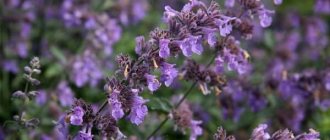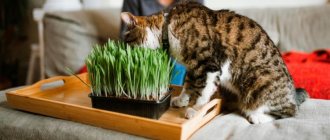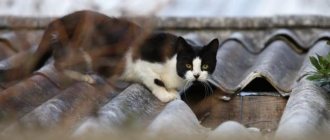Many cats are partial to indoor plants. Moreover, they often like to taste something that has an attractive smell to them. Sometimes owners don’t even think that plants growing on windowsills can become a real threat to the health and life of their pets.
Let's look at how plants are dangerous and which ones are completely poisonous for cats; Are flowers in bouquets dangerous? what are the symptoms of a cat leaving and how to provide first aid.
Common plants and flowers that are poisonous to cats
Many toxic plants are irritants: they cause local inflammation of the skin, mouth, stomach, etc. Toxic substances from other plants can have systemic effects and damage or alter the function of the cat's organs, such as the kidneys or heart.
Here is a list of some common plants that are toxic to cats:
- Amaryllis (Amaryllis spp.)
- Autumn crocus (Colchicum autumnale)
- Azaleas and rhododendrons (Rhododendron spp.)
- Castor bean (Ricinus communis)
- Chrysanthemum, chamomile, mother (Chrysanthemum spp.)
- Cyclamen (Cyclamen spp.)
- Daffodils, Daffodils (Narcissus spp.)
- Dieffenbachia spp.
- English ivy (Hedera helix)
- Hyacinth (Hyacintus orientalis)
- Kalanchoe (Kalanchoe spp.)
- Lily (Lilium sp.)
- Lily of the valley (Convallaria majalis)
- Marijuana (Cannabis sativa)
- Oleander (Nerium oleander)
- Peace lily (Spathiphyllum sp.)
- Pothos, Devil's Ivy (Epipremnum aureum)
- Sago palm (Cycas revoluta)
- Spanish thyme (Coleus ampoinicus)
- Tulip (Tulipa spp.)
- Yew (Taxus spp.)
Bouquets
Hyacinth (Hyacinthus)
pollen, leaves, stems, flowers, bulbs
toxic poisoning, impaired coordination of movements, heart failure
Iris, aka iris (Íris)
leaves, roots
vomiting, diarrhea
May lily of the valley (Convallaria majális)
vomiting, diarrhea
Calla lilies
contain oxalic acid,
irritation of the oral mucosa, laryngeal edema, impaired coordination of movements, acute heart failure
Lily (Lílium)
pollen
laryngeal edema, impaired coordination of movements, heart failure
Narcissus
leaves, flower stalks and bulb scales
vomiting, diarrhea, convulsions, heart and pulmonary failure
Snowdrops (Galanthus)
the entire plant, especially flowers and berries,
after the cut flowers stand in water, the poison ends up there too. Don't let cats drink from the vase. Flowers and berries cause allergic reactions, digestive system dysfunction, and even cardiac arrest.
Tulip (Túlipa)
pollen, bulbs, leaves,
toxic poisoning, impaired coordination of movements, heart failure, allergic dermatitis
Chrysanthemum
irritation of the oral mucosa, vomiting, diarrhea, convulsions, renal, cardiac and pulmonary failure, allergic dermatitis
What parts of the plant are toxic to cats?
If a plant is poisonous to cats, assume that all parts of the plant are poisonous, although some parts of the plant may have higher concentrations of the toxic substance than others.
Toxic doses can vary widely from plant to plant. In some cases, ingesting small amounts can have devastating results, while cats may require exposure to relatively large amounts of other plants before symptoms appear.
How to tell if a cat has been poisoned
The first symptoms indicating intoxication:
- poor appetite;
- impaired body movements;
- drying of mucous membranes;
- lethargy (the kitten loses interest in games, spends more time in solitude, often sleeps);
- difficulty breathing (wheezing may occur);
- paralysis;
- vomit;
- bowel dysfunction;
- increased salivation.
Each cat goes through this process differently. If in one case the symptoms appear several hours after ingestion of the harmful plant, then in another situation the poisoning is protracted and chronic. How quickly the consequences will be felt depends on the amount of weed eaten. You cannot do without medical intervention, because it is possible to completely cure a cat only with drug therapy or in an inpatient setting.
Symptoms to watch out for
Since many plants are irritants, most symptoms observed will be the result of irritation or inflammation, such as redness, swelling, or itching of the eyes, skin, or mouth.
When deeper parts of the gastrointestinal tract, such as the stomach and intestines, become irritated, vomiting and diarrhea are likely.
If a toxic principle directly affects a specific organ, the symptoms observed will be primarily associated with that organ.
For example:
- Difficulty breathing (if the airways are affected)
- Drooling or difficulty swallowing (if the mouth, throat, or esophagus is affected)
- Vomiting (if the stomach or small intestine is affected)
- Diarrhea (if small or large intestine is affected)
- Excessive drinking and urination (if kidney damage)
- Fast, slow, or irregular heartbeat and weakness (if the heart is affected)
Possible consequences
Contact with plants that are dangerous to cats can lead to various consequences. The negative influence of some colors can accumulate, causing the animal's health to deteriorate over time. Other plants can lead to serious poisoning and a sharp deterioration in the animal’s condition.
Symptoms of allergies caused by plants:
- tearfulness;
- nasal discharge;
- frequent sneezing;
- the appearance of inflammation on the skin;
- the animal constantly scratches one place (muzzle, withers or another).
If harmful components enter the body, the following symptoms may occur:
- increased salivation;
- diarrhea;
- nausea;
- decreased appetite;
- decline in activity.
In case of poisoning, the following symptoms are observed:
- frequent and severe vomiting (sometimes mixed with blood);
- diarrhea;
- significant increase in body temperature;
- complete loss of appetite;
- a sharp decline in activity, apathy.
In case of severe poisoning, the animal’s condition deteriorates sharply and quickly. Intoxication leads to disruption of internal organs, which can result in the death of the animal. This is why in case of poisoning you should immediately consult a doctor. Sometimes the hours count!
Immediate help
If you see your cat eating a plant and you are not sure whether it is poisonous, or even suspect that your cat has eaten such a plant, do the following before taking her to the vet:
- Remove all plant materials from your cat's fur, skin, and mouth if you can do so safely.
- Keep the cat in a safe environment for close monitoring.
Plant identification is very important in determining treatment. If you don't know the name of the poisonous plant your cat was exposed to, bring a sample of the plant or plant material that your cat vomited to your veterinarian's office.
Non-hazardous plants
There are plants that have a very unpleasant smell for cats. You can put them on the windowsill without fear, because your pet won’t even come near it.
We recommend the article: Coronavirus in cats. Symptoms Dangerous consequences.
Plants that your cat definitely won’t touch:
- lemongrass;
- mandarin;
- sheddock;
- kinkan;
- calamondin;
- panderosa;
- coleus canine (has an unpleasant odor not only for cats, but also for other animals).
Houseplants that are generally safe for cats:
- violet;
- chlorophytum;
- jasmine;
- camellia;
- begonia;
- dracaena;
- peperomia;
- arrowroot;
- indoor grapes;
- coleus;
- Venus flytrap.
It should be noted that these plants are safe for most cats. However, there remains a possibility that these plants may cause an allergic reaction in some animals.
Cat grass (sprouted oats) can be called not only a safe, but even a useful plant. Its seeds are sold in pet stores. It sprouts within a few days and does not require special care. Such grass will delight the owner with its beautiful greenery, but the cat will be able to chew it to its heart’s content, get all the necessary components and cleanse its stomach.
Vomiting after eating cat grass is not a sign of poisoning.
The following plants are also beneficial for cats:
- mint;
- thyme;
- cat mint;
- valerian;
- thyme;
- Melissa.
But it is worth remembering that the cat should not consume too much of these plants, otherwise an overdose or an allergic reaction is possible. Valerian and catnip are especially dangerous, as some cats react too zealously to their smell. These herbs can be dried and filled into cat toys.
Treatment
Your veterinarian may give your cat anti-vomiting medications and/or activated charcoal to absorb any toxic substances that may be in the intestines. Your veterinarian may also prescribe a treatment such as sucralfate, which protects the damaged areas of the stomach.
Supportive care such as intravenous fluids, anti-nausea medications, feline pain medications, and anti-inflammatory medications will be used as needed. Depending on the toxin and the cat's condition, other treatments may be needed.
What to do if your cat eats plants but doesn’t want to part with them
To stop your cat from chewing leaves, you can dilute a little lemon juice in water or infuse orange peels and spray the plant with the solution. The bright citrus aroma will scare away your pet, but in return you need to offer him special sprouted grass, ordinary millet or oats, which he can and should enjoy to his own pleasure.
Care
Ingestion of some poisonous plants can be fatal to cats, especially if treatment is delayed. Other plants can cause enough damage that long-term care in the form of medication or a special diet will be required.
Be sure to follow your veterinarian's instructions and ask any questions you may have.
Take all possible measures to protect your cat from exposure to poisonous plants. This includes removing such plants from the home and keeping the cat indoors or closely monitoring any outdoor activities.
How to save a flower without harming your cat
Owners do not always want to part with poisonous indoor plants and flowers for cats, especially with an expensive, rare species or a valuable gift. What to do without causing damage to the cat’s health? The following precautions will help:
- place pots with poisonous flowers on the top shelves or on cabinets where the animal will definitely not reach;
- periodically spray the leaves of the plants with lemon juice (any other citrus will do) or put the fruit slices/zest directly into the pot - cats don’t like strong fruity aromas, so they definitely won’t go near the pot;
- Another bitter “anti-rodent” will also work: for educational purposes, spray the stem and leaves with the liquid;
- Place cacti in smaller pots around the cat’s main “enemy” in a pot, thereby creating a “thorny fence” (however, there is still a risk of the cacti tipping over);
- treat the windowsill with vinegar solution;
- hang plants on special plastic holders for pots;
- leave flowers in the loggia without letting the kitten in;
- alternate plants, growing species with a persistent aroma (tangerine, coleus dog, kincan) next to dangerous flowers;
- protect from small kittens with thick curtains, through which the cats will not be able to get to the potty;
- development of a reflex - a radical method of weaning a pet from chewing leaves and stems, consists of spraying the cat with a spray bottle immediately after he starts chewing the greens (after a couple of weeks of such prevention, the cat will forget the way to the desired flower).
In order not to deprive your pet of the pleasure of eating greens, buy special grass for cats at the pet store. It grows all year round. At the same time, you will be calm about the animal’s well-being, and the kitten will receive a complex of necessary vitamins and will not harm your favorite flower.
Rue - cats don't like its smell
Common rue grows up to a meter in height and its flowers are small and yellow. The plant is not used to decorate houses, but it is used in herbal medicine. However, this is not the only function that a regular root can perform. Cats don't like its smell, so many people grow it in the garden to scare away unwanted guests.
Is your home visited by your neighbors' pets and are you concerned about the health of your cats? Then take care of your health and get ordinary rue, which will scare off uninvited guests with its aroma. Lavender will work in a similar way, but not all cats will bypass it.
- Common rue is a plant that decorates gardens and is used in herbal medicine. Cats don't like its smell, so you can sow it on your property to deter intruders.
Precautionary measures
If the owner does not know whether dracaena is poisonous or not for cats, then he does not need to grow this flower in the house. You should always remember which flowers are poisonous to cats and which are not. It is advisable to keep only non-poisonous plants in the house, such as arrowroot, roses, coleus, cacti, catnip, violets (but not uzambara), cereals, basil, mint, thyme, lettuce, parsley. If, after all, there is a dangerous flower in the apartment, then it must be placed in the most inaccessible place for the cat.
Following safety measures and choosing the right home flora is a great way to decorate your interior without harming your pet. But before buying, you need to read the description of the flower and check the prohibited list.
How can you use your cat's dislike of citrus fruits for beneficial purposes?
From the above, you have already understood that with the help of citrus essential oils you can wean your animal off unwanted things. Let's take a closer look at the options in which citrus fruits will help train your pet:
- If your cat does not go to the litter box, but does it in another place. If you are faced with such a situation, then you can apply citrus essential oils to the places where the cat relieves itself, and be sure that it will not go there again;
- If your cat often breaks furniture or chews wires. Many people think that this problem occurs only among those who have dogs. But, in fact, cat owners also face this problem. All you have to do is apply a few drops of essential oil on the furniture or wires and your problem will be solved;
- If your cat is marking territory. Those pet owners who have a cat know that at a young age these little furry friends constantly mark their territory, for example, corners, things, etc. This is a serious problem, because this smell is extremely difficult to remove. Therefore, if you want to get rid of such a problem or avoid its occurrence, then take note of this simple method;
But this method has several nuances. Firstly, the essential oil will quickly dissipate and its smell will not be felt, so you will have to repeat this procedure often until the pet learns to behave as expected. Secondly, there is a more serious problem such as allergies. Many pets cannot tolerate citrus odors and may suffer from them, so consider whether the risks are worth it and consult with your veterinarian to make sure your cat is not allergic.
Why do cats eat houseplants?
When in their natural habitat, felines always add green plants to their diet. They make up for the lack of vitamins contained in herbs, and also help themselves get rid of hairballs that accumulate in the stomach when licked.
It is for this reason that, obeying instincts, domestic cats often encroach on the greenery that appears in the house. But many indoor, garden and field wild crops, as well as ornamental plants in a bouquet, can be life-threatening.
There is no point in looking for this plant in old books on indoor floriculture.
Curriculum Fundamentals of landscape design (Landscape organization of your personal plot) Nearby groups For children and cats, all plants of the aroid family (aglaonema, alocasia, dieffenbachia, calla, monstera, syngonium, spathiphyllum, etc.), kutra (tabernemontana, plumeria), ivies, bulbous plants, euphorbias (containing milky sap) and many others.
During the period when a small child is learning about the surrounding environment, be vigilant to avoid trouble, because many poisonous plants are beautifully flowering or have decorative foliage. Out of curiosity, a child may pull parts of the plant into his mouth.
Until the child is intelligent, it is better to put it in an inaccessible place, or even give the green saboteur to someone. Regular consumption can cause serious disruption to the functioning of internal organs, stomach, heart, and with a large dose, even a single consumption can cause acute poisoning.
As for cats, everything is more mysterious. Obeying natural instinct, they not only dig and scatter the earth, but also enthusiastically chew the leaves of dracaenas, crassae, orchids, and special gourmets can even encroach on a cactus. One pussy replenishes the vitamin deficiency, the second tries to free the stomach from accumulated hair, which motivates the third cat, known only to the sphinx.
Try not to buy plants that may be attractive to your pet. There are definitely no such plants - and it may turn out that you don’t feed your Muska viscosity - let him chew a plant that doesn’t arouse interest in other cats.
If you do not use fertilizers to feed plants, then “excavation work” will not bring any harm to the cat, although the plant may not only be seriously damaged, but also die. Tasting plants should not be allowed. If the cat still tries to taste dangerous plants, you need to remove them (the higher the better), but the most reliable option is to hang them so that a curious creature cannot reach them.
Adenium obese (thick) - (Adenium obesum)
It is the most poisonous of indoor plants.
Adenium is one of the most amazing beautifully flowering succulent plants, and is called Desert Rose in English-speaking countries.
It is also called “impala lily”, “star of Sabinia”, “rose of the succulent world”.
Previously, this strange plant with a thickened stem could only be seen in botanical gardens. There is no point in looking for this plant in old books on indoor floriculture.
From botanical gardens, this poisonous plant came into indoor gardening only after it was grafted onto oleander.
Symptoms:
Literally all its parts can cause serious poisoning.
Fortunately, this insidious flower is not yet very common among us.
Large-rooted alocasia (Alocasia macrorhiza Schott)
Family Araceae (Araceae). Species: Araceae (Araceae) Alocasia Neck.
Alocasia (Amazonian, Sandera, cap, copper-red, fragrant.)
They are rarely described in reference books and even less often found in stores. Unfortunately, alocasia feels better in greenhouses than in apartments.
Indoor, ornamental, medicinal plant. The plant is very poisonous.
Symptoms:
Burning sensation in the mouth and throat. Profuse salivation. Alocasia juice is a strong poison that causes inflammation of all mucous membranes with tissue destruction, bloody, smelly and especially irritating discharge. The entire digestive tract from the mouth to the anus is inflamed: the mucous membrane of the oral cavity is bright red, the color of fresh meat. Salivation is extremely profuse, irritating and offensive. Lesions and films, after removal of which the mucous membrane looks like living meat. Causes real lenticular spots and a scarlet-like rash on the skin. Stomach upset, vomiting (late). With a strong dose: drowsiness, cardiac distress.
Treatment:
Drink water, but not carbonated water, or tea. Do not give milk under any circumstances - it promotes the absorption of poison. Induce vomiting to remove toxins from the body. Give water to drink, tilt the upper body forward, irritate with a teaspoon or finger. Give an activated carbon tablet to bind the remaining poison. Take the tablet with water or tea. Dangerous. Call an ambulance, provide first aid.
AGLAONEMA (Aglaonema)
Aglaonema is a close relative of Dieffenbachia, differing from it most often in having narrower, white-spotted, gray-green or silver-patterned leaves.
About 50 species are known.
The plant is poisonous - substances contained in the cell sap can cause skin irritation.
Symptoms:
The juice protruding from the incision site causes swelling and soreness in the mucous membranes of the mouth and throat, and if it comes into contact with the eyes, it causes conjunctivitis and changes in the cornea.
ANTHURIUM (Anthurium Schott)
In culture, species and garden forms of the genus Anthurium are extremely widespread and are considered leaders among aroids in popularity, primarily as cut plants. About 28 species of the genus and over 77 garden hybrids (including 45 with the participation of Anthurium Andre) are widely available in the world commercial trade; the number of cultivars is extremely large and can hardly be adequately assessed at present.
Symptoms:
The juice contains a strong poison that causes inflammation of all mucous membranes with tissue destruction, bloody, smelly and especially irritating discharge.
ARISAEMA
Its wild ancestor is known as ARONICA or ARUM, which gives its name to the Arumaceae (Araceae) family.
The British call Arizema “Cobra-Lilies” for the peculiar shape of the inflorescences, reminiscent of a cobra stand.
Symptoms:
Burning sensation in the mouth and throat. Profuse salivation. Arisema triphyllum (Arum triphyllum) is a strong poison that causes inflammation of all mucous membranes with tissue destruction, bloody, smelly and especially irritating discharge.
The entire digestive tract from the mouth to the anus is inflamed: the mucous membrane of the oral cavity is bright red, the color of fresh meat. Salivation is extremely profuse, irritating and offensive. Lesions and films, after removal of which the mucous membrane looks like living meat.
Arum triphyllum causes real lenticular spots and a scarlet-like rash on the skin.
Treatment:
Drink water, but not carbonated water, or tea. Do not give milk under any circumstances - it promotes the absorption of poison. Induce vomiting to remove toxins from the body. Give water to drink, tilt the upper body forward, irritate with a teaspoon or finger. Give an activated carbon tablet to bind the remaining poison. Take the tablet with water or tea.
Dangerous. Call an ambulance, provide first aid.
“Calla” - Aronik (Arum)
Arum spotted, arum cornatum (saaromatum cornatum). Starch root, ox tongue, snake flower. It also blooms in the winter months.
Symptoms:
Burning sensation in the mouth and throat. Profuse salivation. Stomach upset, vomiting (late). With a strong dose: drowsiness, cardiac distress.
Treatment:
Drink water, but not carbonated water, or tea. Do not give milk under any circumstances - it promotes the absorption of poison. Induce vomiting to remove toxins from the body. Give water to drink, tilt the upper body forward, irritate with a teaspoon or finger. Give an activated carbon tablet to bind the remaining poison. Take the tablet with water or tea. Dangerous. Call an ambulance, provide first aid.
Azalea or Rhododendron
Rhododendron leaves contain alkaloids used to produce narcotic drugs.
Azalea is an ornamental plant whose stems and leaves can be chewed and swallowed by small children.
Fresh leaves are poisonous due to the content of the glycoside andromedotoxin.
Symptoms:
Profuse drooling. Nasal discharge. Tearing. Vomit. Amaryllis belladonna L
Hybrid hippeastrum (Hippeastrum hybrida).
Family - Amaryllidaceae (Amaryllidaceae)
Amaryllis belladonna has dense peduncles with 6-12 flowers in an inflorescence. blooms in autumn.
Hippeastrum hybrid is distinguished by hollow peduncles and 3-6 flowers in an inflorescence; it blooms in winter or spring.
Amaryllis are rich in the alkaloid lycorine, which stimulates the vomiting center in the brain. Poisoning occurs when the plant's bulb is mistaken for an onion.
Symptoms:
Small doses of hippeastrum bulb, like amaryllis, serve as a known emetic; larger doses are highly poisonous.
The leaves of this species have the property of calming cramps and spasms.
Eucharis grandiflora or "Amazon lily" Eucharis grandiflora Planch. et. Lindl. (Eucharis amazonica Lindl.)
Sem. Amaryllidaceae (Amaryllidaceae).
See Amaryllis.
ORIENTAL HYACINTH (Hyacinthus orientalis)
Hyacinth contains colchicine. Poisonous.
Symptoms:
The alkaloid colchicine damages the microtubular apparatus of cells and stops their division. It also damages nerves (transport of substances along nerve endings stops) and blood vessels. Whether it hurts or not is unknown, but nerve damage sounds scary. A very beautiful chemical name is Acetyltrimethylenocolchicic acid.
These are extremely poisonous plants. Damaged bulbs release the alkaloid colchicine, which can cause burns on your hands. But not only the corm, but also the above-ground organs contain various alkaloids. Poisoning can be very severe: after a few hours, a burning sensation in the throat, dizziness and nausea occurs, which can later develop into colic, paralysis and collapse. Since all parts of the plant, and even the water in which the flowers stood, are poisonous, you should handle colchicum carefully and wear gloves.
In large doses (one bulb is enough for a child) it causes nausea, vomiting, severe diarrhea, hair loss, bleeding disorders and kidney damage.
Gloriosa superba
Indoor and garden-ornamental poisonous plant.
Poisoning is possible when eating a plant bulb (mistaken for an onion).
Symptoms:
All parts of the plant contain colchicine and similar poisonous alkaloids. Contact with the stem and leaves may cause skin irritation for some.
In large doses (for a child this is one bulb) it causes nausea, vomiting, severe diarrhea, hair loss, bleeding disorders and kidney damage.
Deadly poisonous to cats.
Dieffenbachia - (“silent reed”, “mother-in-law”)
Dieffenbachias are able to improve the chemical composition of the air in the room where they are located, which is especially important in city apartments.
Symptoms:
When eaten, the poison enters primarily into the oral cavity. Some irritants, such as arum plants (Dieffenbachia, etc.), act mainly at this level. Chewing Dieffenbachia can cause the tissues in the mouth to become so swollen that it causes temporary loss of speech.
FICUS (Ficus)
Ficus rubbery, tiny, sacred, Benjamin, lyre-shaped, ivy-shaped, obtuse, rough. Ficus carica (fig, fig tree, wineberry, fig tree) and others.
Symptoms:
It should be remembered that some plants are completely harmless for most people, but can cause various allergic reactions in people with hypersensitivity: bronchial asthma, swelling of the mucous membranes, vomiting, diarrhea.
If it comes into contact with the skin, the poisonous juice can cause acute inflammation, eczema, dermatitis, etc. Those suffering from “rubber” disease need to know that, for example, ficus trees can cause disturbance to their body. Or rather, the proteins contained in the juice of this home plant.
Microscopic droplets seeping onto the surface of the leaves enter the air and then into the respiratory tract, causing an allergic reaction.
According to experts, this popular indoor plant, which has a lot of varieties, for example, the fashionable small-leaved Ficus Benjamin, ranks third among allergens after dust mites and pets.
Those who are allergic to latex may experience a cross-reaction to fruits and vegetables. And not for the notorious strawberries and citrus fruits, but for pineapple, avocado, banana, dates, peanuts, kiwi, mango, cherry, melon, soybeans, tomatoes and even potatoes.
Well, what is bad for a person is very bad for a cat.
PHILODENDRON (Philodendron)
Philodendron Sodiro, blushing, rough, warty, graceful, climbing, Sello, scaly. Monstera is lovely.
The sap of philodendrons, like all aroids, is more or less poisonous, so children should not be allowed to come into contact with the plant.
Symptoms:
Burning sensation in the mouth and throat. Profuse salivation. The juice is a strong poison, causing inflammation of all mucous membranes with tissue destruction, bloody, smelly and especially irritating discharge.
Stomach upset, vomiting (late).
Treatment:
Drink water, but not carbonated water, or tea. Do not give milk under any circumstances - it promotes the absorption of poison. Induce vomiting to remove toxins from the body. Give water to drink, tilt the upper body forward, irritate with a teaspoon or finger. Give an activated carbon tablet to bind the remaining poison. Take the tablet with water or tea. Dangerous. Call an ambulance, provide first aid.
CYCLAMEN
The plant is also known under other names: dryakva, alpine violet.
Some species, such as Colchis cyclamen, Kuznetsov's cyclamen and others, are on the verge of extinction and are listed in the Red Book of Plants.
It should be remembered that it is a poisonous plant. Traditional medicine advises using Cyclamen root juice for sinusitis by instilling it into the nose. This is very dangerous, you can burn the mucous membrane
Symptoms:
Fever, sore throat, difficulty breathing, severe sneezing, cough...
Fresh juice from cyclamen tubers may also cause skin irritation or inflammation.
BITTERSWEET NIGHTLIGHT (Solanum dulcamara (L.)
The genus contains both agricultural crops (potato, eggplant, tomato) and medicinal plants (bittersweet nightshade and black nightshade). Also called indoor cherry, Jerusalem cherry, bzdnika, baznik, and voronyazhka.
Among indoor nightshades, about 50 South American perennial species and many varieties are popular
Symptoms:
Many nightshades are poisonous; if consumed in large doses, poisoning can lead to convulsions, paralysis and even death. It should be used with caution in case of diseases of the liver and pancreas. It is contraindicated for hypotension and vegetative-vascular dystonia. Its preparations should not be taken for gastrointestinal diseases with diarrhea, and its fruits should not be taken for flatulence. Nightshade is contraindicated during pregnancy.
BROWALLIA speciosa Hook
As a rule, there is no point in preserving plants in winter, since browallias quickly age and bloom worse and worse. It is better to buy a new flowering plant every year.
See nightshade.
Cypress Euphorbia (Euphorbia cyparissias (L.) Scop)
It has many varieties - Euphorbia cypress, twig-shaped, beautiful or poinsettia, Akalifa bristle-haired, croton, otherwise codiaum, African euphorbia.
Be careful. Please remember that all these plants are poisonous. It is advisable to work with them wearing gloves. And after work, wash your hands.
Symptoms:
The milky juice of euphorbia can cause burning and blistering on the skin, and if it gets into the eyes, it causes painful irritation of the cornea, sometimes temporary blindness.
If ingested - nausea, vomiting, diarrhea, abdominal pain. Heart failure may develop.
The taste of the milky juice is very sharp and burning. Therefore, animals avoid touching milkweeds. In the body of the plant, the juice is under some pressure, and as soon as a leaf or twig is broken, it comes out and enters the mouth before the animal has time to move away. The juice burns, and the animal remembers this plant well.
Treatment:
Gastric lavage, activated carbon. For abdominal pain, inject a 0.1% atropine solution subcutaneously
Akalifa bristle-haired
Croton, otherwise Caladium See Euphorbia.
Poinsettia See Euphorbia.
Euphorbia See Euphorbia
OLEANDER (Nerium oleander)
Its flowers look very impressive in winter, when there is snow outside, but you need to think about whether there is enough space in your room for such, frankly, not a small shrub.
Toxic, contains cardiac glycosides used in medicine.
Symptoms:
Deaths have occurred from consuming wood as fuel and making tea from the leaves.
After a few hours, abdominal pain, nausea, vomiting, bloody diarrhea, tachycardia (fast heartbeat), and visual effects begin. Later, a rare slow irregular pulse, a drop in blood pressure followed by cardiac arrest.
If ingested, it causes disturbances in cardiovascular activity. Attention! Care must be taken when handling this plant, as its wood and sap are poisonous.
HYDRANGEA (Hydrangea)
All parts of the plant contain cyanogenic glycosides; eating them is contraindicated.
An excessive dose may produce more cyanide than the body's metabolism can handle.
However, cases of poisoning are rare as the plants do not appear attractive as a food source.
Symptoms:
An excessive dose may produce more cyanide than the body's metabolism can handle.
However, cases of poisoning are rare as the plants do not appear attractive as a food source.
CLIVIA
The rhizomes of Clivia cinnabar are extremely toxic due to the presence of a number of alkaloids in them, the most famous of which is lycorine, which is characteristic of many members of the Amaryllis family. Clivia cinnabar contains up to 0.4% lycorine in dry matter.
Clivias contain the alkaloid lycorine, clivimine and clivatin.
Symptoms:
In small doses, lycorine causes drooling, vomiting and diarrhea,
in large ones - paralysis and collapse.
If milky sap appears at the site where the plant was cut, you should immediately wash your hands thoroughly.
When you are handling any plant, do not touch your eyes with your hands.
Particularly dangerous for children.
Dipladenia (Mandevilla)
PACHYPODIUM (Pachypodium).
Sem. Kutrovye (Apocynaceae).
Plants of the Kutrov family (Apocynaceae) contain substances that affect cardiac activity. True, serious danger threatens only those who swallow flowers or leaves in large quantities.
Symptoms:
They taste very bitter and initially cause vomiting. However, with this family of plants, especially for children! should be handled with care.
From those that are conditionally non-toxic, but it is still better not to eat them frequently - arrowroot, stromantha, spathiphyllum, pelargonium (geranium), ctenanthe, calathea, chlorophytum, cissus, cyperus, ferns, tradescantia, netcreasia.
Many cat owners claim that their pet was poisoned by chrysanthemum. Upon further clarification, it turns out that the plant was from a bouquet and therefore underwent special chemical treatment. Therefore, it is not the plant that is to blame for the poisoning, but the chemicals that were on the leaves.
Among the flowers in bouquets, aconite, periwinkle, privet, lilies of the valley, hydrangeas, crocuses, lady's slipper, anemone (anemone), common columbine, wisteria (Chinese, profusely flowering, multi-flowered), spring adonis (adonis spring, summer, golden, Amur) are also dangerous , yellow flower, golden flower, starodobka, bathing grass, Montenegrin), delphinium, dicentra (diclitra), sweet clover (officinalis, white, serrated), smoke grass (pharmaceutical), smoke grass, rutka), yellow jasmine, common honeysuckle (wolfberry), honeysuckle (black, small-leaved, Korolkova, Maaka, alpine, Alberta, brilliant, fragrant), edible honeysuckle, common goldenrod, anagyrofolia ("golden shower"), iris (yellow, false calamus, swamp, water, ariform, "water iris" ), kalmia (narrow-leaved, broad-leaved, multi-leaved), castor bean, European bathwort (European yellowhead, avdotka, frying, troll flower), broad-leaved kupena (medicinal, pharmaceutical, fragrant, Caucasian, multi-flowered, squat, whorled, changeable, pink, Solomon's seal , arsenic, snake root), phytolacca, lily, clematis (clematis stinging, oriental, grape-leaved), toadflax (snapdragon, shoehorn), hellebore, foxglove (digitalis), narcissus, holly, tansy, beautiful pikulnik, peony, bedstraw , woodgrass, broom (willow, yellow acacia (caragana), white, Robinia - pseudoacacia, fragrant rue, boxwood, lilac, snowberry, yarrow, common hop, corydalis, Lobel's hellebore, bird cherry, sage of fortunetellers (salvia), ash, aconite ( wrestler), barvino.
It is advisable to wear gloves when working with a poisonous plant. And after work, wash your hands.
Author of the article: Mirakina Irina Anatolyevna, agronomist, phytodesigner, teacher of original programs, teacher of special and general professional disciplines at the School of Landscape Design
How to stop a cat from chewing unsafe greens
To ensure that plants that are dangerous to domestic cats are harmless, you need to place them in inaccessible places: high shelves or niches. You can hang flowers in flower pots. It is better if such plants are located in an enclosed space, for example, a heated balcony, where the pet is not allowed access.
To satisfy your pet's need for greens, sprout oat or wheat seeds that contain beneficial substances. The sprouts sprout quite quickly, and to obtain a useful harvest you only need gauze, a saucer and water.
Vomiting after eating cat grass is not a symptom of poisoning!
Window sills, as well as the plants themselves, can be sprayed with a solution of lemon essential oil; it repels cats with a pungent odor. In the pet store today you can find sprays that dissuade animals from eating dangerous greens, but are not harmful to plants. They also use dried citrus peels, placing them in a pot or next to it, but this will not discourage persistent individuals.
As protection, they suggest using double-sided tape, sticking it next to plants and on pots. The cat will be disoriented, falling into the “trap”; in addition, the smell of the adhesive composition is unpleasant for four-legged animals.
Many owners use the reflex effect. To achieve it, you need to spray the plant hunter with a spray bottle every time he tries to attack green spaces. In this case, you need to act long and hard so that the relationship between these two actions is imprinted in the cat’s head.
A cat will appreciate grass grown especially for it.











